Steamed Jam Pudding. This is one of my favorite puddings that I used to enjoy when I was in the UK. In the UK the term pudding is used to describe the dessert course, not that milky creamy concoction we enjoy as pudding here in North America.
I remember being asked when out for dinner after I first got over there, what would I like for pudding. I didn't see anything remotely resembling the pudding I was used to back home. It was then explained to me that a pudding was anything that you would eat for dessert.
Steamed puddings come in many varieties. A steamed pudding is a steamed cake, more or less. Moist and delicious.
Slightly stodgy. Beautiful served warm, generally with custard in the UK, but ice cream is also very nice with them.
You can get steamed ginger puddings, chocolate puddings, vanilla puddings, carrot puddings etc. Each one tasting very lovely indeed.
I have quite a few different recipes for steamed puddings posted here on the blog. Mary Berry's Christmas Pudding is one, which is typical of a Christmas pudding, or what we might call Plum Pudding in North America.
Another favorite of mine is Carrot Pudding. This was my ex Mother In Law's answer to Christmas pudding. A lot cheaper to put together and so delicious. Like a steamed carrot cake. I love it!
Steamed Cherry Bakewell Pudding is another delicious one. Flavored with almond, with a lovely cherry jam topping.
I am also very fond of this Steamed Marmalade Pudding, which is rich and sticky and somewhat reminiscent of a gingerbread pudding.
As you can see we are rather overly fond of puddings here in The English Kitchen, especially traditional ones. This is only the tip of the iceberg!
WHAT DO YOU NEED TO MAKE A STEAMED PUDDING
On this occasion I am going to talk equipment-wise, rather than ingredient wise. One of the basic tools you will need is a pudding basin. A pudding basin is a ceramic bowl that the batter for the pudding it put into before steaming.
Pudding basins (aka “pudding bowls”) are dishes designed particularly for steaming puddings in. They will have thick walls and tall, thick, pronounced rims around the tops of them. The thick walls help to provide steady heat; the rims are designed to allow a cover to be tied securely on top.
You can make do with a pyrex mixing bowl if you need to. The most important thing is that it is heat proof. You can get pudding basins here in Canada. This is actually the type that I use.
You will also need a large deep pot to steam it in. You can use a stock pot with a metal trivet in the bottom to hold the pudding basin on if you wish. Just put the covered pudding basin on top of the trivet in the saucepan and add boiling water to come no more than half way up the sides of the pudding basin.
You can also use a dedicated steamer pot, which is one that has a steaming basket on the top and a saucepan on the bottom that you put the boiling water in. You can find one of those here.
It has been my experience however that most are normally not tall enough to hold a pudding basin in the steaming basket, but you could get lucky. You want the steaming basket to be at least six inches tall if not more.
Making the pudding batter itself is really quite easy. If you can mix together a cake, you can mix together a pudding batter. Its that simple.
In the case of this jam one, you will need to mix some jam and lemon juice together to place onto the bottom of the buttered pudding basin.
Today's recipe was adapted from one found in the cookery book, Just Like Mother Used to Make, by Tom Norrington-David. He called it Toenail Pudding. Apparently the coconut is supposed to look like toenail clippings.
This involves pleating a sheet of grease-proof/waxed/parchment baking paper to tie over the top. You will need a round that is the size of the circumference of the bowl plus an additional three inches, at least.
This needs to be pleated in the center to allow for the pudding expanding as it cooks. Some people also add a sheet of foil and the paper needs to be buttered. This gets tied on.
There is an excellent tutorial here on Good to Know that you can go and see which really explains the whole procedure very well. If you follow that, you cannot go wrong.
There may be a bit of fuss and muss to this, a bit of faffing about, but trust me when I say that they are worth every bit of trouble. These are quite simply some of the best desserts going.
In the UK they always serve them with warm custard sauce. Here is the recipe I use to make a custard sauce.
Proper Custard

Yield: about 3 cups
Prep time: 5 MinCook time: 15 Mininactive time: 10 MinTotal time: 30 Min
This is also known as creme anglaise. Be sure not to let the mixture boil once the eggs are added, or you wil end up with a curdled mess. You only need to heat it up enough to cook the eggs. The custard is ready when it coats the back of a wooden spoon.
Ingredients
- 8 egg yolks
- 1/3 cup (75g) granulated sugar (in the UK use caster sugar)
- 1 1/4 cup (300ml) whole milk
- 1 1/4 cup (300ml) double cream
- 1 vanilla pod, split (alternately use 1 tsp pure vanilla extract or paste)
Instructions
- Beat the egg yolks and sugar together in a bowl until well blended. Place the milk and cream in a saucepan with the vanilla. Scrape the insides of the vanilla pod into the mixture before you add it. Bring the mixture just to the boil.
- Pour a little of this mixture into the eggs to temper them, and beat it together well. Pour this back into the pan and whisk together. Return to the heat and using a whisk, lightly stir until it begins to thicken. DO NOT BOIL.
- As the egg yolks warm, the cream will get thicker and create a custard. Keep stirring until it coats the back of a wooden spoon. Remove from the heat and pass through a fine sieve. Leave to cool a bit before using. Serve warm or allow to cool completely, stirring occasionally.
You can even find it at Walmart.
Its very quick and easy to make and pretty much fool-proof for those of you who worry about making the real deal. And I know a lot of people are intimidated by the idea of making custard from scratch.
In any case, if you are looking for a real comfort food type of dessert, you can't go wrong with a steamed pudding, especially a Steamed Jam Sponge Pudding. I like to use Strawberry Jam myself, but any kind of jam will work well.
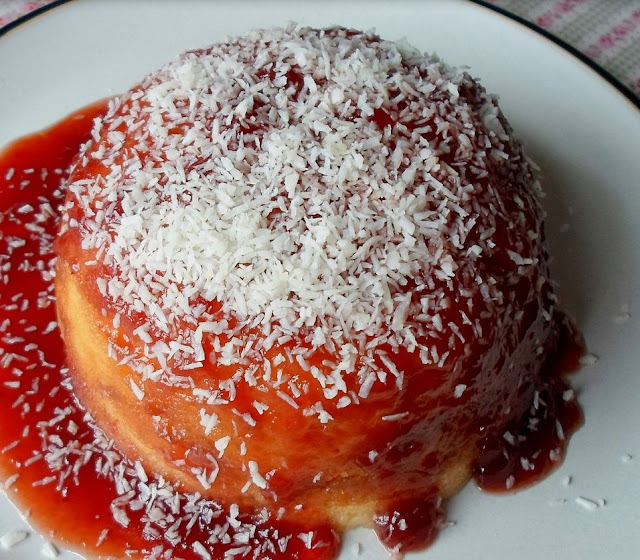
Steamed Jam Pudding
Yield: 4
Prep time: 15 MinCook time: 2 HourTotal time: 2 H & 15 M
Exactly what it says, a steamed jam pudding. Moist and delicious cake coated with sweet jam. If you sprinkle desiccated coconut on the finished pudding to serve, it becomes Toenail Pudding.
Ingredients
- 50g butter softened, plus more for buttering the pudding basin (3 1/2 TBS)
- 1/2 cup (100g) caster sugar (fine granulated sugar)
- pinch salt
- 4 TBS whole milk
- 2 large free range eggs
- 1 cup (140g) self raising flour
- the juice of half a lemon
- 3 TBS raspberry jam
- Desiccated coconut to finish (completely optional,as little or as much as you like)
- Pouring cream, ice cream or warm custard to serve
Instructions
- Butter a medium sized pudding basin or Pyrex bowl well. (It should hold at least 3 1/2 cups) Set aside.
- Cream the butter and sugar together until light and fluffy. Beat in the eggs one at a time. Stir in the flour alternately with the milk to give you a smooth pourable thick batter.
- Whisk the lemon juice into the jam to loosen it. Spoon it into the bottom of the pudding basin. Cover with the pudding batter.
- Take a large piece of grease proof paper. (parchment or waxed paper) Fold a pleat in the middle. Butter the paper. Place on top of the pudding basin and secure with a thick rubber band.
- Place the pudding basin in the top part of a steamer and place over simmering water. Cover tightly. Steam for about 2 hours. Check periodically to make sure the water doesn't boil dry, topping it up every so often with more boiling water. The pudding will be ready when it is well risen and set on top.
- Carefully remove the pudding basin from the pan. Uncover and allow it to rest for a few minutes.
- Run a palette knife around the edge of the basin to loosen and carefully tip out onto a serving platter.
- Sprinkle with as much or as little desiccated coconut as you desire (if using). Serve, warm and cut into thick wedges with either pouring cream, ice cream or warm custard.

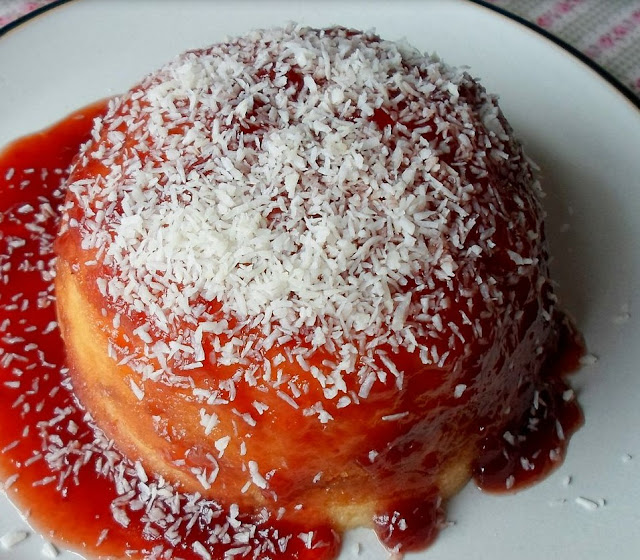
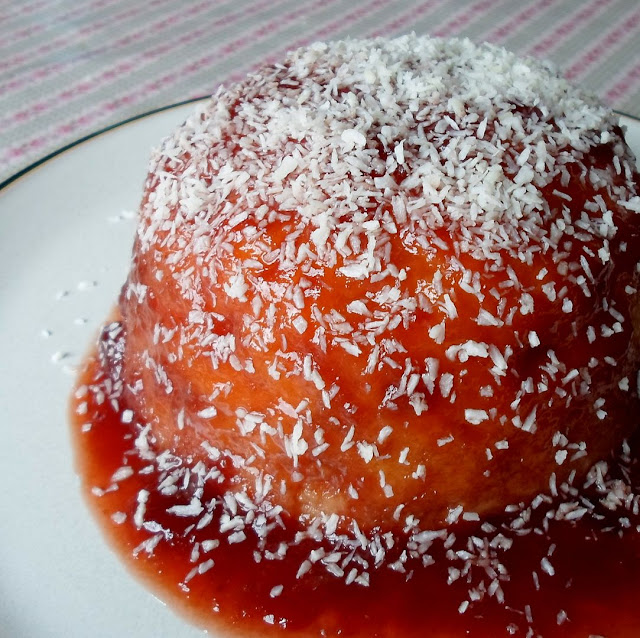
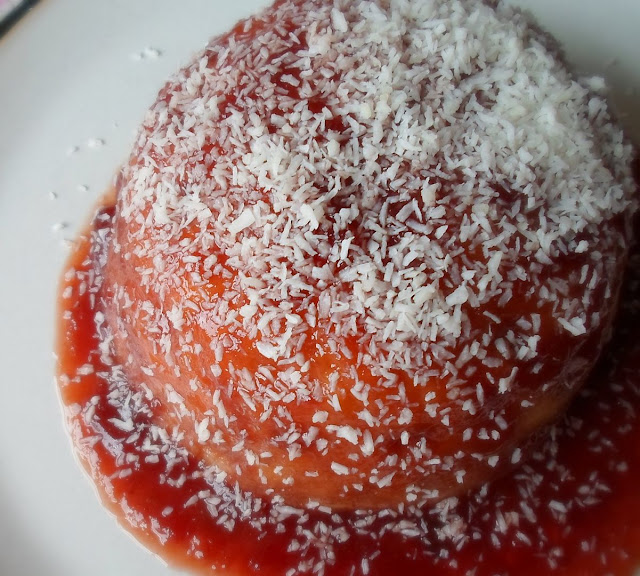



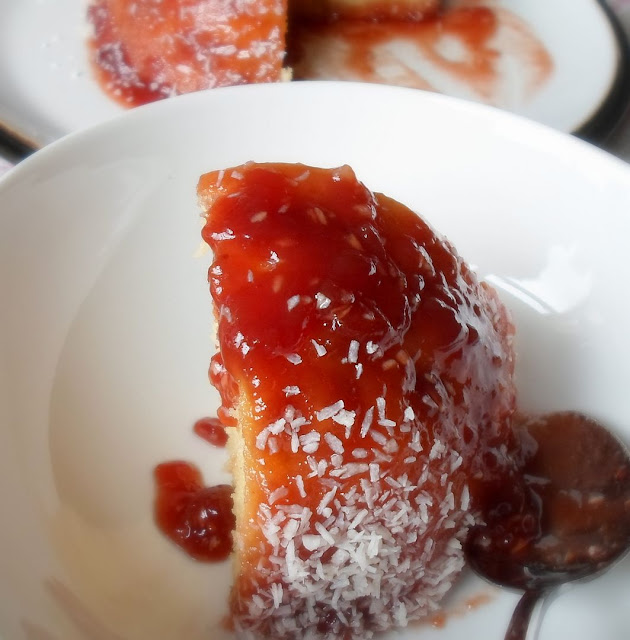
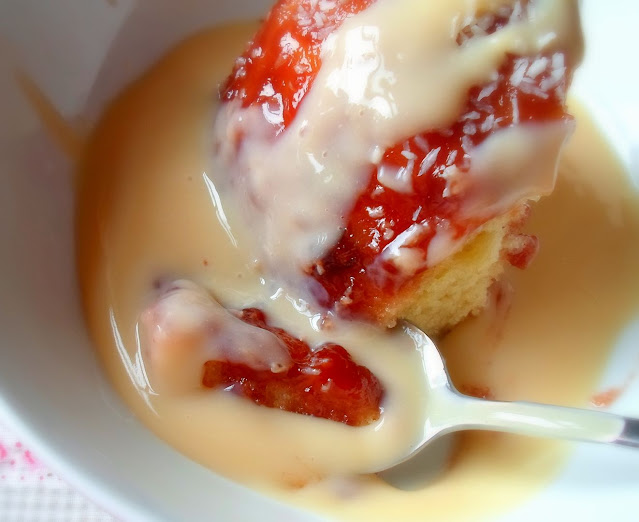
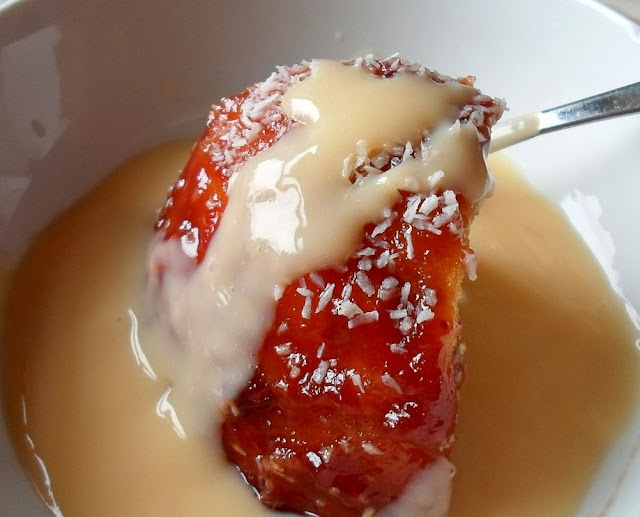
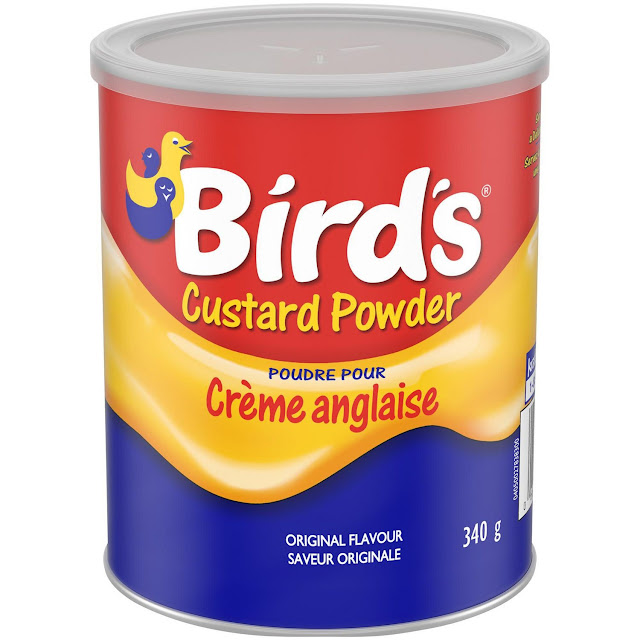












Ahh.... a trip down memory lane for me. Mum made these a lot in winter as it was a cheap way to make a filling dessert for a large family. We had jam made from our own fruit (sometimes Golden Syrup) and the rest consists of basic pantry ingredients and as you say, a pudding basin. We'd have a big one and boil it in the laundry copper.
ReplyDeleteI do love these, but sadly there are no pudding basins to be had here. I've resorted to simply making a microwaved syrup or jam sponges - the best I can come up with. But I loved seeing it all set out just as mum would have made them. Yum!
Aww that's so sad Marie. If I could afford to do so I would send you one! I always love reading about your mom and the things she did for you as a child. It warms my heart. Thank you for sharing! xoxo
DeleteWhilst a pudding basin is best any kind of reasonably deep heatproof dish should work, although you might have to make more pudding which obviously would be a hard ship as you would have to miss out on your first course to make room for it!
DeleteI've tried the treacle pudding it's delicious, thank you.
ReplyDeletethe coconut is actually meant for the oven version so it will brown on top
ReplyDeleteActually, and I should have said this in the write up, this recipe comes from a book by Tom Norrington-Davies, entitled "Just Like Mother Used to Make," and it called for the desiccated coconut to be sprinkled on the finished steamed sponge, once it was turned out. He called it Toenail Pudding, which I thought a bit vulgar. But hey ho!
Delete